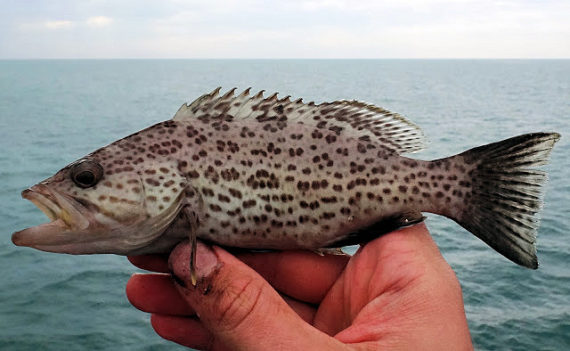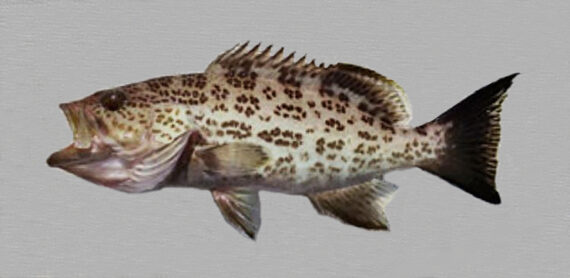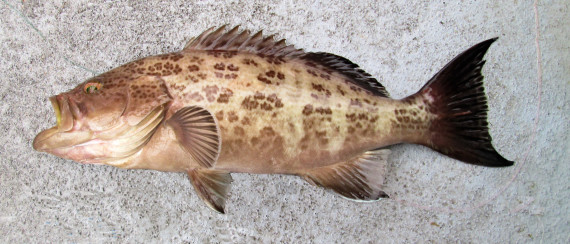Scamp, Mycteroperca phenax
 Scamp, Mycteroperca phenax, Juvenile. Fish caught from coastal waters off Long Island, New York, December 2022. Length 13.3 cm (5.3 inches). Catch, photograph and identification courtesy of James Lafontaine, Long Island, New York.
Scamp, Mycteroperca phenax, Juvenile. Fish caught from coastal waters off Long Island, New York, December 2022. Length 13.3 cm (5.3 inches). Catch, photograph and identification courtesy of James Lafontaine, Long Island, New York.
 Scamp, Mycteroperca phenax, Juvenile. Fish caught from coastal waters off Key Largo, Florida, December 2013. Length: 13.4 cm (5.3 inches). Catch, photograph and identification courtesy of Ben Cantrell, Peoria, Illinois.
Scamp, Mycteroperca phenax, Juvenile. Fish caught from coastal waters off Key Largo, Florida, December 2013. Length: 13.4 cm (5.3 inches). Catch, photograph and identification courtesy of Ben Cantrell, Peoria, Illinois.
 Scamp, Mycteroperca phenax, Cat’s Paw Phase. Fish caught from coastal waters off St. Petersburg, Florida, May 2016. Length: 36 cm (14 inches). Catch, photograph and identification courtesy of Eli (obsessiveangling.wordpress.com).
Scamp, Mycteroperca phenax, Cat’s Paw Phase. Fish caught from coastal waters off St. Petersburg, Florida, May 2016. Length: 36 cm (14 inches). Catch, photograph and identification courtesy of Eli (obsessiveangling.wordpress.com).
 Scamp, Mycteroperca phenax, Cat’s Paw Phase. Fish caught out from coastal waters off the Florida Middle Grounds, December 2013. Length: 58 cm (23 inches). Catch, photograph and identification courtesy of George Brinkman, Guelph, Ontario, Canada.
Scamp, Mycteroperca phenax, Cat’s Paw Phase. Fish caught out from coastal waters off the Florida Middle Grounds, December 2013. Length: 58 cm (23 inches). Catch, photograph and identification courtesy of George Brinkman, Guelph, Ontario, Canada.
The Scamp, Mycteroperca phenax, is a member of the Grouper or Epinephelidae Family, and is known in Mexico as abadejo garropa. Globally, there are fifteen species in the genus Mycteroperca, of which eleven are found in Mexican waters, seven in the Atlantic and four in the Pacific Ocean.
The Scamp is a small grouper that has an elongated robust compressed fusiform body. They have four color phases: the brown phase when their head and body are pale brown and covered with small reddish brown spots that extend onto their pectoral and pelvic fins; the “cat’s paw” phase (pictured below) when they have several clusters of dark brown spots resembling cat paw prints on their sides; the large adult and gray-head phase when the rear two-thirds of their body is dark and their head and front portion of their body are silvery gray with dark reticulations; and the bicolored phase where the pale brown anteriorly abruptly changes to dark chocolate brown posteriorly. Their anal fin has 3 spines and 10 to 12 rays; their caudal fin is strongly concave with rays projecting unevenly beyond the margin; and, their dorsal fin has 11 spines and 16 to 18 rays. Their body is covered with rough scales.
The Scamp is found in reef environments and over rocky bottoms at depths between 30 m (100 feet) and 100 m (330 feet). Juveniles can be found in shallow waters around jetties and within mangrove areas. They reach a maximum of 1.07 m (3 feet 6 inches) in length and 14.5 kg (32 lbs) in weight. As of January 1, 2024, the International Game Fish Association world record stood at 14.51 kg (32 lbs 0 oz) with the fish caught in coastal waters off North Carolina in June 2016.
Scamps frequent areas where the Oculina coral thrive and are voracious ambush predators feeding on small fish, cephalopods, and crustaceans. They are aggregating spawners with females significantly outnumbering males indicative that they are protogynous hermaphrodites who change from female to male at mid-life. Each female releases between 1,300,000 and 10,500,000 eggs annually. They have a lifespan of up to thirty years.
The Scamp is a resident of all Mexican waters of the Atlantic Ocean including the Gulf of Mexico and the east coast of the Yucatán Peninsula in the Caribbean.
The Scamp, due to its multiple coloration, is very similar to six groupers of the Mycteroperca genus found in Mexican waters of the Atlantic: the Black Grouper, Mycteroperca bonaci, the Gag Grouper, Mycteroperca microlepis, the Tiger Grouper, Mycteroperca tigris, the Western Comb Grouper, Mycteroperca acutirostris, the Yellowfin Grouper, Mycteroperca venenosa, and the Yellowmouth Grouper, Mycteroperca interstitialis. Correct fish identification requires consultation with someone having knowledge of the groupers in the area or about the differences in the groupers of the Mycteroperca genus.
From a conservation perspective the Scamp is currently considered to be of Least Concern with stable, widely distributed populations. This classification will most likely be downgraded in the immediate future as they are a popular commercial and recreational fish that are heavily overfished. In some areas they have some protection through a limit on commercial fishing permits, seasonal closures, minimum size catch restrictions, and area closures. In addition, the Oculina Coral banks in which they reside are threatened by bottom trawlers. In a study conducted between 1979 and 1997 the median length of a Scamp decreased by 7%, there was a 60% reduction in fish over 10 years of age indicating that the abundance of larger females who produce more eggs had significant diminished, and there was a significant reduction in the male population. They are considered excellent table fare.